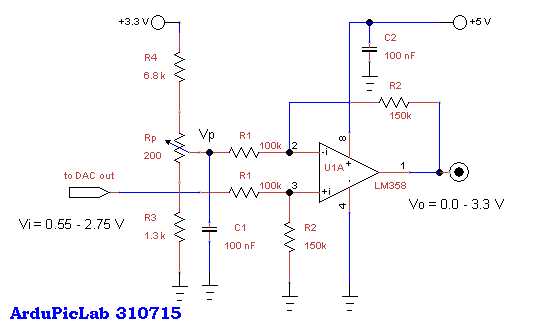标签:
Arduino Due does not have an analog output voltage from 0 V to Vref,
but from 1/6 to 5/6 of the reference voltage, that is, 0.55 V and 2.75V with Vref = 3.3 V.
This is also confirmed by the Atmel (see bibliography).
The output voltage range of the DAC is only 2.75-0.55 = 2.2 V, with a resolution of 2.2/4095 = 0.5372 mV.
A simple differential amplifier, realized with an op amp, is used to remove the 0.55 V offset
and to amplify the output signal in order to reach the desired value.
The following figure shows the scheme of this circuit:

To generate the voltage Vp = 0.55 V, that is, the minimum value of the DAC, is used the divider formed by R3, R4 and Rp.
The trimmer pot Rp is used to adjust Vp in order to have an output value close to 0 V in correspondence with the number 0 sent to the DAC.
With a single power supply you can never get exactly 0V but you approach some mV, about 8 in my prototype.
The differential amplifier has the following gain:
G = Vo/(Vi-Vp) = R2 / R1
Vo = R2/R1 * (Vi-Vp)
Just change the gain, for a different output voltage, but less than 4 V,
With a gain G = 3.3 /2.2 =
1.5, the output of this circuit has the desired range from 0 to 3.3V.
It is recommended to use resistors with a tolerance of 1% or less,
particularly for the four resistors of the amplifier.
Don’t use operational amplifier as LM741, LM1458, TL081
and other that are not suitable for single-supply.
How to modify analog output range of Arduino Due
标签:
原文地址:http://www.cnblogs.com/shangdawei/p/4805963.html
